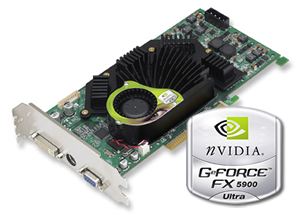Nvidia GeForce FX 5900 Ultra: updated benchmarks

Editors' note Because of the discovery that Nvidia has optimised the GeForce FX 5900 Ultra's display drivers to perform well on Futuremark's 3DMark03 benchmark, we have retested this card using an updated version of 3DMark.
The next great heavyweight bout is underway for high-performance game enthusiasts -- and we don't mean a cool new boxing game. ATI and Nvidia have been waging a fierce battle for the right to say that it -- and not the other -- has the world's speediest GPU (graphics processing unit), and both have recently landed new punches.
Nvidia's latest contender is the GeForce FX 5900 Ultra, the successor to its GeForce FX 5800 Ultra. When the 5800 Ultra finally hit the market, it was months late, contained a very noisy fan, and took up two slots on a system's backplane. And if that wasn't enough, its performance did not live up to expectations. Outcry from the gaming community did not fall on deaf ears, and Nvidia got a successor to the 5800 Ultra out the door as soon as possible. Although it's not as quiet as a church mouse, the 5900 Ultra's fan won't draw comparisons to a vacuum cleaner, either. The 5900 Ultra, however, is just as bulky as the 5800 Ultra, and it still takes up two slots.

With a few architectural changes to the GPU, it is no surprise that the 5900 Ultra is noticeably faster than the 5800 Ultra. The 5900 Ultra doubles the 5800 Ultra's memory interface from 128 bits to 256 bits, and the on-board memory jumps from 128MB to 256MB. The 5900 Ultra also adds a few new texture-compression technologies. And finally, Nvidia has had a few more months of driver development to further optimise the driver -- always a big factor when it comes to boosting performance.
Testing time -- updated
Nvidia sent us a reference-design version of the 5900 Ultra and beta drivers, which we pitted against the latest release from ATI, the Radeon 9800 Pro 256MB. Determining which of the two cards is fastest, however, is not as easy as one might think.
When we originally ran our 3DMark03 (Build 320) tests, the 5900 Ultra ran circles around the 9800 Pro 256MB. During testing, however, it came to light that some possibly unorthodox rendering techniques were being used by the 5900 Ultra's display drivers, which were artificially inflating its scores. The developer of 3DMark03, Futuremark, quickly released an updated version of the benchmark (Build 330), which defeats the known 3DMark03-specific optimisations built into the current Nvidia driver. With the updated version of 3DMark03, the 5900 Ultra's 3DMark03 scores dropped by between 14 and 22 percent, depending on the resolution and the feature settings. At both 1,024 by 768 and 1,600 by 1,200 with no advanced features enabled, the Radeon 9800 Pro 256MB is now noticeably faster. However, once anti-aliasing and anisotropic filtering are enabled, the performance of the two cards is almost identical.
In the Flyby-Antalus portion of our Unreal Tournament 2003 tests, the 5900 Ultra was consistently faster than the 9800 Pro 256MB. However, on the less-GPU-intensive Botmatch-Antalus portion of the test, the results were more mixed, with both cards taking the lead, depending on the individual test.

The tables turned somewhat in the Tom Clancy's Splinter Cell tests, with the 9800 Pro 256MB besting the 5900 Ultra when we enabled the highest-quality settings -- albeit by a maximum of 8 percent.

The bell has sounded, and we have the always-unpopular split decision. In the end though, it's difficult to declare which card is the performance champ. Whether the 5900 Ultra has a slight edge over the 9800 Pro 256MB is debatable, depending on the scores you look at; however, Nvidia has at least caught up with ATI in terms of super-fast 3D graphics performance. Expect to see GeForce FX 5900 Ultra boards by the middle of June selling for $499 (~£300) from numerous vendors, including Asus and Creative Labs. There will also be a 128MB version available for $399 (~£240).